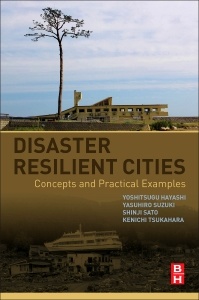Disaster Resilient Cities Concepts and Practical Examples
Auteurs : Hayashi Yoshitsugu, Suzuki Yasuhiro, Sato Shinji, Tsukahara Kenichi

Disaster Resilient Cities: Concepts and Practical Examples discusses natural disasters, their complexity, and the exploration of different ways of thinking regarding the resilience of structures. The book provides a blueprint for structural designers to better prepare structures for all types of natural hazards during the design stage.
Brief and readable, this book analyzes various examples of disaster damage from earthquakes, tsunamis, and floods, together with their causal mechanisms. Practical methods to plan and design structures based on their regions, cities, as well as the particular countermeasures are also included for study.
Chapter 1. Introduction - Why Resilience is Lost?Chapter 2. Emerging Crisis in Resilience over the world2.1 The Great East Japan Earthquake (Kato T., Sato)2.2 Mega-flood in Bangkok, Thailand (Nakamura)2.3 Super-typhoon Haiyan in Philippines2.4 Disaster resilience learned from the 2007 Peru Earthquake2.5 Losing resilience of Nomadic life due to urbanization in Mongolia (Ishii)2.6 Losing reconstruction capacity of traditional wooden houses in JapanChapter 3. Learning Disaster Resilience from the Great East Japan Earthquake3.1 Understanding spatial variation of tsunami3.2 Understanding of tsunami damages as "Lost Stock"3.3 Measuring damage and recovery status of residents in terms of "Quality of Life"Chapter 4. Regional Grand Design for Improving Disaster Resilience4.1 Optimum sea-wall height based on risk analysis with land use and soft measures4.2 Earthquake damage risk evaluation by micro geo data4.3 Consensus building for resilient society4.4 Resilient grand design based on QOL4.5 Paradigm change in flood protection strategies for enhancing resilience (Kachi)4.6 Smart shrink strategy and the fiscal system
Structural Engineers, Earthquake Engineers, Structural Designers, and Construction Engineers
Professor, Disaster Mitigation Research Center, Nagoya University
Professor, Department of Civil Engineering, the University of Tokyo
Professor, Disaster Risk Reduction Research Center, Graduate School of Engineering, Kyushu University
- Proposes new methods and policies for enhancing structural resilience for key urban infrastructure
- Includes examples of disaster damage as a result of earthquakes, tsunamis, floods, and their structural countermeasures
- Presents case studies that cover specific mega disasters, such as the Great East Japan Earthquake and tsunami, Super Typhoon Hyan, and Bangkok flood
Date de parution : 03-2016
Ouvrage de 206 p.
15x22.8 cm


